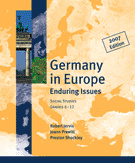Introduction

- This unit is about globalization – the creation of the European Community and Germany’s role in creating this model of cooperation.
- This unit is about the value of immigrants - with concerns about the influx of immigrants many countries, including Germany, forget their contributions.
- This unit is about people moving freely across borders in harmony with each other.
... at least in a political, economic, and social sense.
Germany and the European Community are part of this larger picture. In recent years, the European scene has changed from one of individual countries and alliances competing with one another to gain the advantage to one of a united Europe confronting the world as an economic, social and political power. And yet there are many people in the world still operating under the old assumption that the United States is the one true super power and the rest of the world will follow its lead. It seems there is much to be learned from the example provided by Germany and the European Community. Germany and the European Community have provided an excellent model for how countries can literally rise from the ashes of war and conflict to build a new model for international cooperation and leadership. The issue now becomes how Germany and the European Community use this new paradigm to encourage a different kind of relationship with the United States which will be beneficial to both. New relationships are built on knowledge and understandings.
These lessons are intended to provide this content and understandings. Students in American high schools need to know far more about Germany and the European Community than can be learned from a chapter in a world history textbook. Since the world history curriculum is crowded with “essential content,” teachers need to determine where and when to stop and have students think about and apply the content they are learning. The emerging model of a united Europe is definitely one of these “post holes.”
It is for this reason that each of the lessons is divided into three steps:
- Gathering Information about the Topic
- Extending and Refining the Information – Using Thinking Skills to Process the Information
- Applying the Information – Using the information in a new context – Applying the information to problem solving and decision-making
- Focus/Unit questions to guide the instruction. Careful use of the material included in the lesson and use of the suggested strategies will enable the students to talk intelligently about the focus/unit questions.
- An outline of essential content. Creative thinking depends on students having a firm knowledge base.
- Suggested checks for understanding – formative assessments to provide feedback to students on the road to understanding.
- Teachers may want to teach all three topics using the materials as suggested and using the transfer task at the end of the topic.
- Teachers may want to use only one of the topics to coincide with a unit they are teaching from another source.
- Teachers may want to use selected handouts and strategies to support lessons from their own curriculum materials.
The lessons contained herein are based on "Understanding by Design" concepts (Grant Wiggins & Jay McTighe).

 Printable PDF
Printable PDF